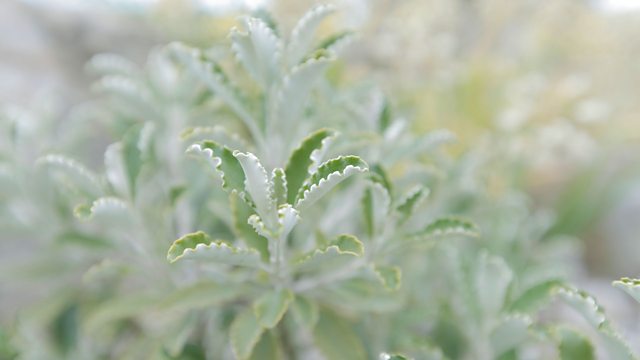Loch Lomond and the Trossachs National Park
Eric Robson hosts the horticultural panel programme from Loch Lomond and the Trossachs National Park. With Chris Beardshaw, Bunny Guinness and Christine Walkden.
Eric Robson hosts the horticultural panel programme from Loch Lomond and The Trossachs National Park.
Chris Beardshaw, Bunny Guinness and Christine Walkden are this week's panellists taking questions from an audience of local gardeners.
The questions range from how to create a sensory garden within an exposed playground, to how best to plant a massive bog garden, and how to keep sawflies away from your gooseberries.
Also, Chris Beardshaw visits the Loch Lomond and Trossachs National Park for a project called Wild Park 2020 whose aim is to eradicate invasive Rhododendrons and reintroduce the lovely red squirrel.
A Somethin' Else production for �鶹�� Radio 4.
Last on
More episodes
Previous
Next
Questions and Answers
Q – I’ve taken lots of growth (2-3ft/60-90cm) off my Rhododendrons and Pieris – will they survive? They’re about 15 years old.
Bunny – I’m sure they will be fine – they’ll grow back come May/June
��
Q – Despite having wonderful soil, with Rhododendrons and Azalias growing well, my Himalayan Blue Poppies have gradually disappeared.�� Why is this?
Christine – I would have thought that this is a varietal issue.�� Many of the poppies are monocarpic – so they race to flower, set lots of seeds, and then pop their clogs.��
Bunny – There could be too much competition.�� They might need a bit more space for the seeds to get more light and room to spread.
Chris – Poppies won’t like the deep shade and the leaf litter from those plants – as well as the root competition
��
Q – We’re in the process of developing our local play park.�� We’d like to create a sensory garden – what plants would you suggest? It is quite open to the elements and we’d prefer native Scottish plants if possible.
Chris – First thing to do is to create some shelter for the more sensitive plants.�� I would look at plants like Acer campestre or Alders or a Corylus etc to create boundaries and defining spaces.�� Then you can put other plants within those boundaries.��
Christine – Try Miscanthuses or things like Stipa (the Golden Oat Grass).�� Pulsatillas in the early spring would be great.�� Nicotiana too.��
��
Q – I’ve had a beautiful crop of gooseberries this year – but I am now getting gooseberry sawfly – can I prevent this from happening?�� They’ve been in the garden for 3 years and a couple of years in pots before that.
Bunny – When gooseberries are on the ground they are far more affected than if they are on a standard about 1m (3ft) up.�� You can fool the sawflies by raising them off the ground.
Chris – Fan training up the wall them helps too – it raises them and spreads them out so the flies just miss them!
Christine – You could also put a physical barrier in the way.�� Things like envirofleece – very fine good quality covering.
��
Q – I live on a farm and have been trying to make a bog garden.�� It is about 75sq metres, it’s heavy clay, and it drains poorly.�� Can you recommend some plants that give diverse colour and form.��
Christine – I think the Trolliuses are very good.�� Also, the Primulas - bulleyana and denticulata – which will cope with soggy, boggy conditions.
Bunny – Lysichiton Americanus – the Skunk Cabbage.��
Chris – Trouble with that is it will get out! It’s a pernicious weed.
Christine – If you like Lysichiton go with camtschatcensis the white one instead.
Bunny – Also, Primula florindae and the japonica.
��
Q – I’ve started growing some Heathers.�� They are growing quite tall (over a foot) – how best to control them?
Chris – Very easy to do.�� If these are traditional heathland heathers then you are talking about Callunas, Ericas, Duboisias – those types of things.�� Best advice is to trim them back to the base of the flower immediately after they’ve finished flowering.��
Christine – Also you can dig a hole, drop them down lower, and then mound up.�� Then they’ll come back stronger.
��
Q – I want to screen a typical barbed wire fence from view – I thought, since it’s wet clay, that I’d raise some Salix alba and keep them shrubby.�� All went well for three years and then the leaves started to go black to die back.
Chris – It is Willow Anthracnose – this is a disease that is specific to Willows, it comes in after the flowering on young shoots first and then races down to the stems.�� It’s very difficult to get rid of I’m afraid.
��
Q – Our garden is 40m long x 7m (131ft x 23ft) wide and currently contains no plants.�� The builders will be finished by the beginning of December… where should we start?
Christine – Don’t rush in! Take your time and think about themes and colours and what you want month-by-month.��
Bunny – I’d draw it out and use tracing overlays to figure it out visually first.����
Broadcasts
- Fri 13 Nov 2015 15:00�鶹�� Radio 4 FM
- Sun 15 Nov 2015 14:00�鶹�� Radio 4
Six of GQT’s naughtiest gardening innuendos
When Gardeners' Question Time got mucky.
Podcast
-
![]()
Gardeners' Question Time
Horticultural programme featuring a group of gardening experts


